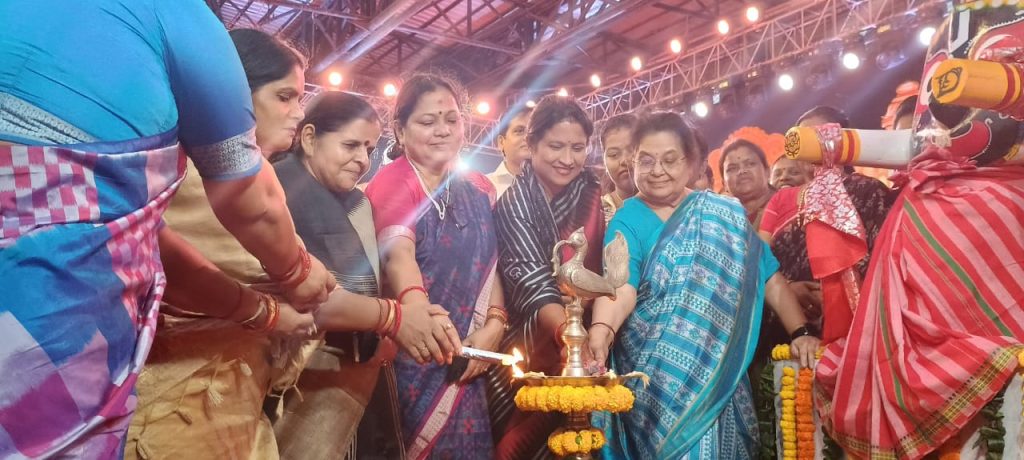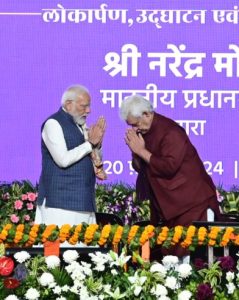16th Finance Commission must ensure gender-based intergovernmental fiscal transfer formula

Image credit X @OSCW_1
Responsive gender budgeting needs institutional framework
By Pradeep Kumar Panda
Bhubaneswar, May 24: Gender budgeting is a public financial management (PFM) tool to translate the gender commitments into budgetary commitments. The gender responsive PFM is a fiscal innovation, and it transcends four stages including knowledge building, creating institutional structures, capacity building and installing accountability mechanisms.
Gender budgeting is emerging as a significant socio-economic tool to analyze budgetary policies to identify their effects on gender equity. Gender budgeting does not mean making separate budgets for women nor is it confined to analysis of earmarked funds for programmes exclusively targeted for women within budgets.
It refers to analysis of the entire budget through a gender lens to identify gender-differential impacts and to translate gender commitments into budgetary commitments. It enhances the transparency and accountability of revenue and public expenditure.
Also Read: Sensex, Nifty eye new peaks amid furious fund buying
Prima facie, the budget may appear to be gender neutral; but due to differences in the socially determined systemic roles played by women and men, budgetary policies have differential impacts across gender. As a consequence, gender neutrality of budgetary policies can turn to gender blindness due to the fact that the women and men are at asymmetric levels of development on the socio-economic scale.
Gender budgeting is not “women budgeting”; rather, it is an analysis of budgets to ascertain the relative benefits (or losses) derived by each gender from a particular fiscal programme/project.
Gender budgeting constitutes one among many macroeconomic policy tools to address gender equity; the prominent among other tools such as monetary policy, trade policy and financial deregulation policy. The gender budgeting is analysed within the overall framework of fiscal policy, and does not focus exclusively on public expenditure analysis.
Watch: #podcast I #book discussion I Waiting for #shiva Unearthing The Truth of Kashi’s #gyanvapi I
The significant elements of fiscal policy viewed through a gender perspective are budgetary allocations, actual expenditure and taxation; fiscal decentralisation and ex-ante gender budgeting; fiscal devolution (intergovernmental fiscal transfers) and aid effectiveness. However, most gender budgeting experiments worldwide have been largely confined to expenditure-side analysis of budgets.
The Public Financial Management (PFM) frameworks for gender budgeting includes the fiscal innovation components of gender budgeting and World Bank by the PEFA Secretariat identifying the nine indicators of gender responsive PFM (GRPFM). Gender budgeting is defined as fiscal innovation and suggested a gender budgeting framework with four components – model building, institutional mechanisms, capacity building and accountability mechanisms.
Also read: China tests military might to ‘seize power in Taiwan’
Innovation is defined as a way of transforming a new concept into tangible processes, resources and institutional mechanisms in which a benefit meets identified problems. GRB is a fiscal innovation in that it translates the gender commitments into fiscal commitments through applying a ‘gender lens’ to the identified processes, resources and institutional mechanisms; and arrives at a desirable benefit incidence.
GRB as an innovation has four specific components: knowledge processes and networking; institutional mechanisms; learning processes and building capacities; and public accountability and benefit incidence.
GRB is emerging as a significant socio-economic innovation tool for transparency and accountability by analysing budgetary policies and identifying their effects on gender development. It has two inevitable dimensions: equity and efficiency.
Also Read: How educated are candidates in Lok Sabha elections?
It is a misnomer that GRB is making separate budgets for women. It is also wrongly interpreted as earmarking of funds for gender development.
GRB is defined as an analysis of the entire budget process through a gender lens to identify the gender differential impacts and to translate gender commitments into budgetary commitments.
The institutional arrangements are crucial for the advancement of gender budgeting as a fiscal innovation. Gender budgeting is a powerful PFM tool to ensure gender equality outcomes, which has inter-sectoral cross-cutting policy concerns.
Watch: #podcast I #book : #nastik why I am not an atheist I Kushal Mehra on #atheism #wokeism & many more.
It is therefore significant for the governments to organize themselves to ensure that decisions on policies and programs to reduce gender inequalities receive equal attention as areas of spending which are under the authority of a specific minister and ministry.
However, many countries have ministries of women or equivalent, of course, but such ministries do not necessarily have responsibility for all areas of spending that reduce gender inequalities. Therefore, gender budgeting as a fiscal innovation requires strong institutional mechanisms to translate the gender commitments into fiscal commitments.
Gender responsive PFM in the form of gender budgeting has led to gender mainstreaming in the budget, with more and more prima facie gender neutral sectors adopting gender budgeting and reporting to the Ministry of Finance on their efforts to address gender equality through fiscal policies.
Also Read: Varun Gandhi makes maiden poll appearance for mother Maneka Gandhi fighting lone battle
Accountability and transparency are part of the objectives of gender budgeting. However, the integration of gender budgeting statements into the budget documents for transparency; and the relevant accountability mechanisms were largely absent in the region. India is an exception, as India has integrated gender within the PFM within the four stages of fiscal innovation.
Gender budgeting is most effective when it involves changes to both policy-making processes – such as determining budgeting allocations and designing programmes – and administrative systems – such as tracking expenditures and monitoring programme outcomes. Changes may be made at a policy level through executive branch decision-making, and/or formalized in budget circulars, the national budget law, or a separate law on gender budgeting.
Almost all countries use a budget call circular or equivalent document that serves as an official notice from the finance ministry instructing government agencies how to submit their annual budget bids. Formalization of the gender budgeting initiative through budget circular has been termed gender budgeting by “fiscal fiat”.
Watch: Lok Sabha Poll in Northeast I Will Saffron surge repeat? I Will CAA & UCC impact elections?
The analysis of “process” indicators of gender responsive PFM (GRPFM) reveals that India is successful in integrating a gender lens within the budget cycle, including in the financial planning and allocation, and in effective implementation. However, a legally mandated GRPFM would be crucial for the sustained impact of gender budgeting on gender equality outcomes.
The gender responsive PFM in India is known worldwide for its sustainability and accountability. As India has advanced in gender responsive PFM since 2004-05, it is important to analyse the link between gender-responsive PFM and gender outcomes.
Gender responsive PFM (GRPFM) has a positive and significant impact on gender parity in education at the upper primary school and lower secondary school levels. The conditional transfers are not significant (Table 4). The results also suggest that economic growth per se is insufficient, given the weak impact of real income changes, and therefore that the government needs to take specific and focused public policy planning and budgeting measures to ensure gender equality outcomes in India.
Also Read: UK ‘infected blood’ report exposes biggest health scandal which left 3k dead
The dependent variables are the gender equality index (GEI) which is captured through female to male ratio of education outcomes in primary, upper primary, lower secondary and upper secondary schools in India.
The unconditional fiscal transfers through Finance Commissions seem to have a direct effect on gender equality outcomes measured by parity in enrolment compared to conditional transfers and therefore integrating gender criteria in intergovernmental formula-linked fiscal devolution would have positive effects on gender equality.
Gender-responsive PFM is very crucial for promoting gender equality outcomes. However, the exact institutional mechanism and fiscal design matter in translating the GRPFM into better gender outcomes. The empirical investigation suggests that unconditional tax transfers have a relatively greater impact on gender equality outcomes than conditional grants.
This calls for the 16th Finance Commission to integrate a gender criterion in the intergovernmental fiscal transfer formula. The channels of impact of tax transfers on gender equality outcomes require meticulous analysis with more detailed fiscal variables across income quintiles and demographic patterns.
Join WhatsApp channel of The Raisina Hills







